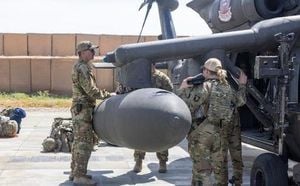On October 1, 2025, the United States entered its first federal government shutdown in nearly seven years, sending immediate shockwaves through the nation’s aviation sector and the broader travel industry. The shutdown, triggered by a funding impasse between President Donald Trump and Congress, left thousands of federal employees in limbo and travelers bracing for disruptions that could escalate the longer the standoff drags on.
At airports large and small—from San Diego International to Palomar in Carlsbad, from Philadelphia to Atlanta—air traffic controllers and Transportation Security Administration (TSA) agents are still reporting for duty. But there’s a catch: they’re working without pay. The Department of Transportation is expected to furlough more than 11,000 Federal Aviation Administration (FAA) employees, and while essential staff keep planes in the sky, support staff—including human resources, aircraft certification engineers, and aerospace engineers—are sidelined until Congress approves new funding (FOX 5/KUSI, Reuters, CBS News Philadelphia).
“The air traffic controllers are on duty right now although they are not getting paid, they are going to work, they are controlling the airplanes just like normal,” explained Kevin Karpé, a former air traffic controller and manager, now CEO of Diverse Vector Aviation Consulting, in an interview with FOX 5/KUSI. But, he warned, “Because of the furlough there might not be enough people to staff every single position in a control facility, especially the larger ones like San Diego, New York, Chicago.”
Indeed, the cracks in the system may not be visible immediately. On the shutdown’s first day, operations at Hartsfield-Jackson Atlanta International Airport—the world’s busiest—continued without a hitch. “At this time, airport operations remain normal,” the airport stated, adding that they were “prepared to address any challenges that may arise.” Passengers like Sam LeBeau, arriving from Charlottesville, Virginia, reported no noticeable change. But as the shutdown lingers, the pressure on essential workers is expected to mount (Atlanta Journal-Constitution).
For TSA agents, the shutdown’s impact is deeply personal. At Philadelphia International Airport, agents kept lines moving and baggage checks running, but the anxiety was palpable. “I have kids, so food, car payments, rent. I don’t want to dig into my savings for all that, but I will if I have to,” one agent, speaking anonymously to CBS News Philadelphia, admitted. The longer the shutdown lasts, the more likely it is that some federal workers will call out sick or simply not show up, especially as bills pile up and paychecks fail to arrive. That’s not just speculation—during the record 35-day shutdown in 2018-2019, Miami International Airport had to temporarily close a terminal because TSA officers were calling in sick at twice the usual rate (Associated Press).
Flight delays and cancellations are among the most immediate risks. With support staff furloughed, there’s less backup for the essential workers who keep America’s airspace safe and efficient. “In the control towers, in the radar rooms, it’s safe, the controllers are coming to work, they may have to slow the system down at times, but that’s just part of not having enough staffing in the first place,” Karpé noted. The FAA has already been grappling with a nationwide shortage of air traffic controllers—a deficit that’s persisted for decades. The shutdown has halted training and hiring, threatening to worsen the shortage and create ripple effects that could last long after the budget crisis is resolved (FOX 5/KUSI, Reuters, Daily Democrat).
The National Air Traffic Controllers Association (NATCA), which represents controllers across the country, has repeatedly sounded the alarm. In a statement issued on the shutdown’s first day, NATCA warned, “This includes aircraft certification engineers and aerospace engineers. Critical safety and technology work, as well as operational support, will not be performed while these workers are furloughed.” The union’s president, Nick Daniels, added, “They’re out there working right now with critical staffing—the lowest staffing we’ve had in decades of only 10,800, where there should be 14,633. And on top of that, they’re working with unreliable equipment.”
It’s not just airport operations at risk. The shutdown has also suspended FAA non-essential activities like inspections, audits, certifications, and air traffic modernization programs. These delays could impact technological upgrades and operational safety in the medium term, compounding the stress on an already strained system (Reuters, Daily Democrat).
The financial toll is staggering. The U.S. Travel Association estimates that the tourism sector could lose $1 billion per week if the shutdown drags on, as reduced passenger demand and higher airline costs take their toll. Traveler confidence, once shaken, may not rebound quickly—even after the government reopens. Airlines face the prospect of reworking schedules, and route planning becomes a guessing game (Reuters, Daily Democrat).
International travelers aren’t immune, either. While the Department of Homeland Security has kept ports of entry open, with about 63,000 Customs and Border Protection workers still on the job, the overall strain on the system could mean longer waits and additional scrutiny at border crossings. Meanwhile, passport and visa processing continues with minimal disruption, as those agencies are primarily funded by application fees. However, the E-Verify program, which helps employers confirm work authorization, is temporarily shuttered (Daily Democrat).
Beyond airports, the shutdown’s tentacles reach into national parks and museums. While the National Park Service’s contingency plan keeps most park roads, trails, and open-air memorials accessible, some sites may close if damage or garbage accumulates. Smithsonian museums and the National Zoo planned to remain open through at least October 6, but further closures could follow if the shutdown persists (Daily Democrat).
For now, travelers can still fly, and the nation’s airports remain open. But the system is growing more brittle by the day. “The system does become a little bit more brittle, the longer this goes, the more the traveler is going to notice it,” said Jeffrey Price, a professor of aviation at the Metropolitan State University of Denver. As more time passes without pay for essential workers, the risk of operational breakdowns, longer lines, and safety lapses grows.
Ultimately, the path back to normalcy rests with Congress. Until a funding agreement is reached, America’s aviation system—already stretched thin—will continue to operate on borrowed time, with the dedication of underpaid workers holding the line for millions of travelers.





